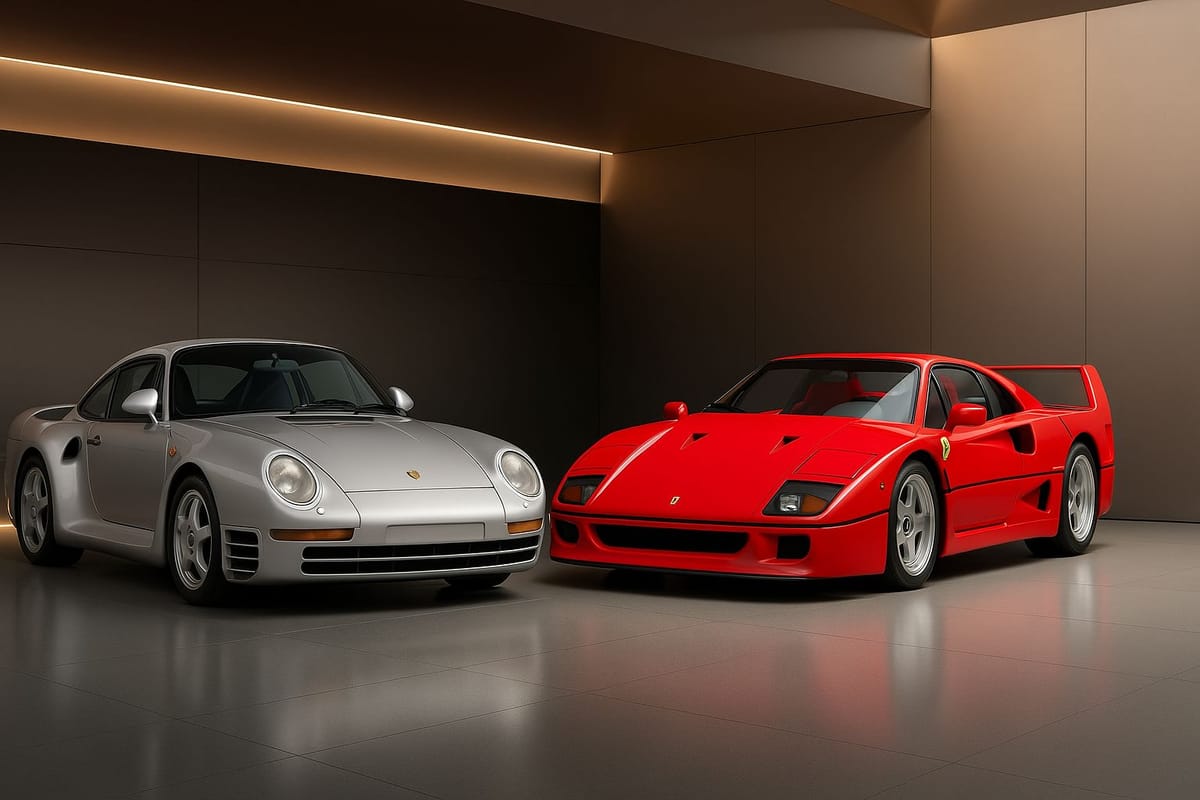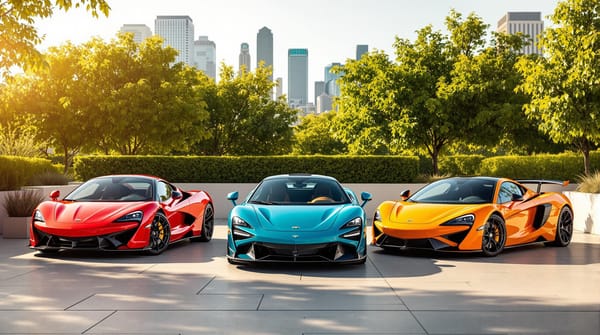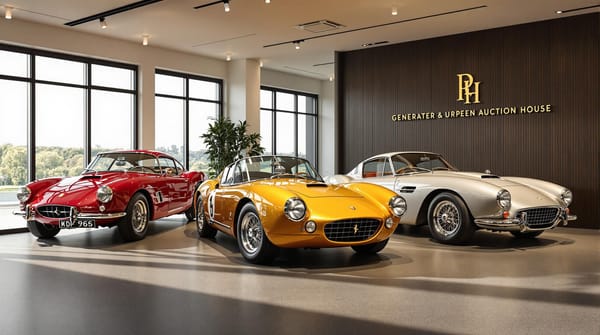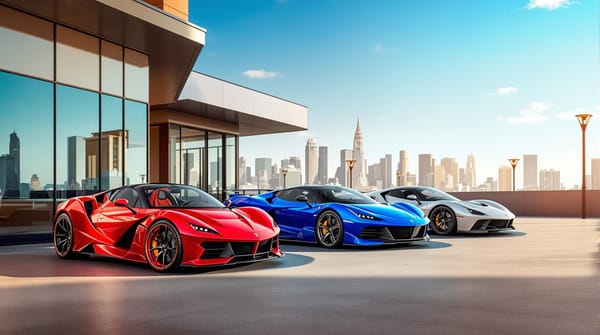Ferrari F40 vs Porsche 959: Investment Comparison
Explore the investment potential of two iconic supercars, comparing their value growth, production rarity, and collector appeal.

Which is the better investment: the Ferrari F40 or the Porsche 959? Here's the quick answer: Both are iconic 1980s supercars with impressive value growth, but they cater to different types of collectors. The Ferrari F40 offers raw performance and emotional appeal, while the Porsche 959 stands out for its advanced engineering and rarity. As of May 2020, the F40 is valued at £1.6M, slightly ahead of the 959's £1.3M.
Key Points at a Glance:
- Price Growth (2006–2020): F40 up 321%, 959 up 319%.
- Peak Value (2017): Both reached £1.75M.
- Production Numbers: F40 (1,311 units) is more common than the 959 (337 units).
- Maintenance Costs: F40 is simpler and cheaper to maintain; the 959’s advanced systems require specialised care.
- Collector Appeal: F40 represents Enzo Ferrari’s legacy; 959 is a technological pioneer.
Quick Comparison
| Metric | Ferrari F40 | Porsche 959 |
|---|---|---|
| Initial Value (2006) | £380,000 | £310,000 |
| Current Value (2020) | £1.6M | £1.3M |
| Peak Value (2017) | £1.75M | £1.75M |
| Production Numbers | 1,311 units | 337 units |
| Top Speed | 201 mph | 197 mph |
| Unique Appeal | Last Ferrari by Enzo | Technological icon |
Both cars are excellent investments, but your choice depends on whether you value raw driving thrills (F40) or cutting-edge innovation (959). Read on for a deeper dive into their market trends, production details, and collector appeal.
1980s Supercar Powertest | Top Gear
Price History
The Ferrari F40 and Porsche 959 have seen notable price increases since the mid-2000s. Here's a closer look at how their values have shifted over time.
Ferrari F40 Price Trends
Back in September 2006, a concours-level Ferrari F40 sold for £285,000. By January 2010, its value had jumped to roughly £440,000, marking a 54% rise. By January 2014, the average price had reached around £750,000, and by January 2017, pristine examples were fetching approximately £1.31 million.
Porsche 959 Price Trends
In September 2006, a concours Porsche 959 was valued at £232,500. By January 2010, well-kept models were worth about £297,000. Between 2014 and 2017, the 959 experienced a rapid rise in value. From a January 2014 valuation of around £615,000, it caught up with the Ferrari F40 by January 2017, with top-condition examples also reaching around £1.31 million.
The table below summarises the price evolution of both cars:
| Year | Ferrari F40 (Concours) | Porsche 959 (Concours) |
|---|---|---|
| 2006 | £285,000 | £232,500 |
| 2010 | £440,000 | £297,000 |
| 2014 | £750,000 | £615,000 |
| 2017 | £1,310,000 | £1,310,000 |
| 2020 | £1,200,000 | £975,000 |
This data showcases the changing investment appeal of these iconic supercars and sets the context for comparing their positions in the market.
Investment Factors
Production Numbers
Production volumes are a key factor in evaluating these vehicles as investments. Ferrari produced 1,311 F40s between 1987 and 1992, while Porsche made just 337 units of the 959 from 1986 to 1993. This stark difference impacts their market dynamics. The 959’s smaller production run makes it nearly four times rarer than the F40, adding to its exclusivity. Meanwhile, the F40’s larger production numbers create a more active market, helping to establish consistent valuation benchmarks.
Brand Appeal
Both cars hold a special place in the collector market, but for different reasons. The Ferrari F40 is admired for its raw performance and iconic design, representing the final Ferrari developed under Enzo Ferrari’s direct leadership. On the other hand, the Porsche 959 is celebrated for its advanced engineering and motorsport heritage, showcasing forward-thinking technology. These unique qualities ensure both models remain highly sought after by collectors.
Running Costs
Maintenance costs are an important consideration for long-term investment returns. The F40’s simpler mechanical design generally results in lower servicing expenses. In contrast, the 959’s complex systems demand specialised care, leading to higher upkeep costs. These differences in running expenses are crucial for investors to weigh when evaluating potential net returns.
Market Outlook
Examining past price trends highlights the strong investment potential for both models.
F40 Market Position
The Ferrari F40's value has seen impressive growth, climbing from £380,000 in September 2006 to £1.6 million by May 2020. This marks a 321% increase. Between 2010 and 2014 alone, its value nearly doubled, rising from £587,000 to £1 million. This surge reflects increasing demand among collectors.
959 Market Position
The Porsche 959 has followed a similarly compelling growth path, though with its own unique characteristics. Its value rose from £310,000 in September 2006 to £1.3 million by May 2020. A particularly sharp rise occurred between 2014 and 2017, when prices more than doubled.
"The most exciting supercar in the world versus the greatest"
Both models have shown resilience in the market. Although values dipped slightly after peaking in 2017, their current prices - £1.6 million for the F40 and £1.3 million for the 959 - demonstrate continued confidence from investors. Limited availability and upkeep requirements play a role in sustaining these strong price levels, with the F40 holding a slight edge over the 959 in terms of value.
Direct Comparison
Building on the price history and market outlook discussed earlier, this section compares key investment metrics for the Ferrari F40 and Porsche 959.
Key Metrics Table
| Investment Metric | Ferrari F40 | Porsche 959 |
|---|---|---|
| Initial Value (Sept 2006) | £380,000 | £310,000 |
| Current Value (May 2020) | £1.6M | £1.3M |
| Peak Value (Jan 2017) | £1.75M | £1.75M |
| Value Growth (2006-2020) | 321% | 319% |
| Performance Credentials | First road car to breach 200 mph | 197 mph top speed |
| Historical Significance | Last Ferrari developed under Enzo Ferrari | Technological pioneer |
| Investment Character | Raw driving experience with emotional appeal | Focus on technical innovation and a refined ride |
This table highlights the unique market trajectories of both models. The Ferrari F40's consistent value growth reflects its historical importance and emotional resonance with collectors. In contrast, the Porsche 959 experienced a sharp surge in value, particularly between 2014 and 2015, when it surpassed the £1 million mark. Its reputation for groundbreaking technology plays a major role in its appeal.
The F40's position as Enzo Ferrari's final creation adds a unique allure, while the 959's advanced engineering and smoother driving experience cater to a different type of collector.
"The fastest sports car in the world versus the best. The most exciting supercar in the world versus the greatest." - Gavin Green
Conclusion
Looking at the investment performance of both vehicles since 2006, the Ferrari F40 edges ahead with a May 2020 valuation of £1.6M, compared to the Porsche 959's £1.3M.
The F40's allure lies in its connection to Enzo Ferrari's legacy and its raw, unfiltered driving experience, representing the height of the analogue supercar era. Its dramatic design and intense performance have driven its value upwards, though its challenging nature makes it less suited for everyday use.
On the other hand, the Porsche 959 stands out for its advanced technology and more driver-friendly nature. With its peak valuation of £1.75M in January 2017, matching the F40's highest point, it demonstrates strong long-term investment potential alongside a more practical driving appeal.




